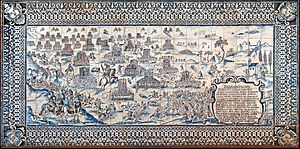Battle of Montes Claros
| Battle of Montes Claros | |||||||
|---|---|---|---|---|---|---|---|
| Part of Portuguese Restoration War | |||||||
 17th century azulejo depiction of the Battle of Montes Claros at the Battles Room of the Palace of Fronteira, Lisbon |
|||||||
|
|||||||
| Belligerents | |||||||
|
|
|||||||
| Commanders and leaders | |||||||
|
António Luís de Meneses Duke of Schomberg |
Luis de Benavides Carrillo, Marquis of Caracena | ||||||
| Strength | |||||||
|
20,000 men:(including 2,000 from British Isles)
|
22,600 men:(including German, Swiss & Italian mercenaries)
|
||||||
| Casualties and losses | |||||||
| 700 dead 2,000 wounded |
4,000 killed 6,000 prisoners |
||||||
20,000 men:(including 2,000 from British Isles)
22,600 men:(including German, Swiss & Italian mercenaries)
The Battle of Montes Claros was fought on 17 June 1665, near Vila Viçosa, between Spanish and Portuguese as the last major battle in the Portuguese Restoration War. It was a great Portuguese victory and is considered as one of the most important battles in the country's history.
By 1665, the Portuguese Restoration War had been raging for 25 years. Despite numerous setbacks, King Philip IV of Spain was determined to crush the Portuguese insurrection. After the disastrous southern campaign in 1662 that culminated in the Battle of Ameixial, the Spanish court evaluated the performance of the Spanish Army and came to the conclusion that the war could only be ended by decisive action. The court believed that the insurrection could only be ended by the capture of a major city or by the complete destruction of the Portuguese Army. Luis de Benavides Carrillo, Marquis of Caracena, a veteran of campaigns in Italy and the Netherlands, was appointed to lead the new invasion of Portugal. Carrillo had served as a field commander and as a military governor, and his organizational skills were lauded. Carrillo planned to end the war by capturing the Portuguese capital of Lisbon. To reach the city, he planned first to take Vila Viçosa, followed by Setúbal.
Once he was in command, Carrillo wanted to gather strength to ensue that he outnumbered the opposing Portuguese Army. However, the illness of King Philip caused the court to order him to procede with the invasion, as they feared that the death of Philip would strengthen foreign support for the Portuguese. The Spanish crown was also facing financial difficulties, and there was a legitimate fear that the army would be disbanded if the war continued.
...
Wikipedia
